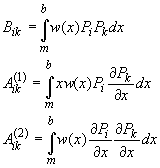Model | Electrophoresis and Other Geometries | linear Lamm equation
Model | Electrophoresis and Other Geometries | external loading cell
For any geometry that is described by a cross-section width w(x), we can write the Lamm equation as
(1)
![]()
For the linear Lamm equation with radial-dependent force, the flux j(x) is
(2)
![]()
Using the same finite element formalism that is explained in the introduction to the Lamm equation solutions, we arrive at matrix elements
(3) 
When working with six-channel centerpieces or external loading cells, the wall of the solution column are not sector-shaped. While this usually does not allow sedimentation velocity experiments, low-speed runs are little affected by the walls (as long as the lateral diffusion is smaller than the sedimentation). Accordingly, for example, the systematic noise elimination procedure is still possible. However, it has to be taken into account that the different geometry of the cell leads to different redistribution of the material, e.g. the absence of radial dilution. This can be taken into account by using the linear Lamm equation model, which uses w(x) = constant. (The ordinary Lamm equation for sector-shaped geometry would use w(x) = x.)
Technically, these functions switch the Lamm equation solutions to use different finite element matrix elements, which have been calculated for the specified geometries accordingly (see below)
A further refinement is implemented for external loading cells. When using external loading cells without oil, the rounded corners of the centerpiece can have a very small effect on the redistribution of the material. In this case, the external loading cell model can be used with a modified w(x). Dependent on the volume of oil used in the experiment (entry required in ml), based on the geometry of external loading cells the bottom location of the solution column is calculated. This allows to take the effect of the rounded corners quantitatively into account. Because of the greater complexity of this Lamm equation model, this function is much slower. In practice, probably the linear Lamm equation model is in most cases sufficient.
Please Note: These models only work in conjunction with the noninteracting discrete species model.
Electrophoresis Geometry: Linear Lamm Equation With Linear Force
Model | Electrophoresis and Other Geometries | Electrophoresis: Lamm equation for discrete species
Model | Electrophoresis and Other Geometries | Electrophoresis: ls-g*(v)
Model | Electrophoresis and Other Geometries | Electrophoresis: c(v) distribution with constant D
These models are variants of the corresponding Lamm equation models (noninteracting discrete species, ls-g*(s) distribution, and c(s) distribution), adapted for the linear geometry of electrophoresis, and the linear force (no radial dependency of the force). This equation is obtained by using the continuity equation (Eq. 1 above) together with the flux
(4)
![]()
in which the sedimentation term is replaced by a term for the electrophoretic mobility (expressed as a linear velocity v). Further, the geometry is not sector-shaped, i.e. w(x) = constant.
All the models work equivalent to their centrifugation counterpart, except that the sedimentation coefficients are replaced by the linear velocity in micrometers/sec. Obviously, the Svedberg equation is meaningless, and the diffusion coefficient is used directly to describe the diffusion of all species.
Also, because the length of the electrophoresis cell is usually known, the ‘bottom’ position is not specified in the parameter input box by its absolute location, but only relative to the location of the ‘meniscus’.